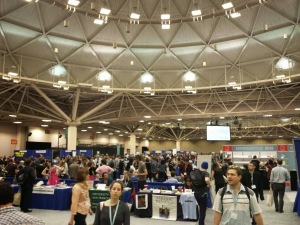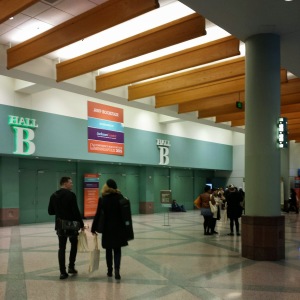#AWP15
April 17, 2015, by Sam Dinger
 If you have any writerly friends or circulate in literary circles, you probably couldn’t help but notice all the #AWP15 hashtags and selfies last week on Facebook, Twitter, and Instagram. Every year at this time the Inprint staff notices a mass exodus of writers leaving Houston for a few days to go to this thing called AWP. Last week it was Minneapolis, next year it will be Los Angeles. One wonders what AWP really is. What happens when so many writers congregate in a square mile? Is it an academically inspired conference where writers exchange thoughtful and innovative ideas, or is it just one big party?
If you have any writerly friends or circulate in literary circles, you probably couldn’t help but notice all the #AWP15 hashtags and selfies last week on Facebook, Twitter, and Instagram. Every year at this time the Inprint staff notices a mass exodus of writers leaving Houston for a few days to go to this thing called AWP. Last week it was Minneapolis, next year it will be Los Angeles. One wonders what AWP really is. What happens when so many writers congregate in a square mile? Is it an academically inspired conference where writers exchange thoughtful and innovative ideas, or is it just one big party?
We asked Sam Dinger, Inprint C. Glenn Cambor/Michael and Nina Zilkha Fellow, Inprint Poetry Busker, and MFA fiction student at the UH Creative Writing Program, to be our eyes and ears at AWP. This was Sam’s first time at AWP and here is how he breaks it down for us.
Inprint: What exactly is AWP? Who attends?
Sam: It’s pretty true to its title–Association of Writers and Writing Programs–so this year Minneapolis was crawling with thousands of people who were either writers or parading as writers, publishers, teachers, agents. Ask any Uber driver. And some of them even liked us. A kind fella who picked me up after I had spent a couple loud hours at the Hilton bar (where everyone seemed to end up) didn’t miss a beat before telling me that he loved giving rides to writers. He said he liked it when there were two of them. That way he could listen to them talk. As I type it, this sounds a little like observing an animal in its natural habitat. And I guess it is. At once, AWP seems to fulfill and complicate all stereotypes of writers. But it’s funniest when it confirms them. I was staying with my aunt and uncle in Minneapolis. And when he picked me up from the airport, my uncle asked, “Did you bring a beret?” When I made it to the convention center the next morning, there were about fifteen people outside for a smoke break, and several wore berets.
Inprint: What was a typical day like for you at the conference?
 Sam: In the days before I headed to Minneapolis for the conference, I realized that I didn’t have a game plan. I had looked at the schedule online (When I later got a paper copy of this at check-in, it was the size of an issue of, I don’t know, Vogue. I just checked the library I’m in for a comparably-sized magazine and couldn’t find one. All too slim.) and tried to narrow down the panel menu to something like two to five (or none if there weren’t any good-sounding ones) per day. And then, as the times for each session would roll around, I would make a quick decision about what I was up for and what I thought would be most useful.
Sam: In the days before I headed to Minneapolis for the conference, I realized that I didn’t have a game plan. I had looked at the schedule online (When I later got a paper copy of this at check-in, it was the size of an issue of, I don’t know, Vogue. I just checked the library I’m in for a comparably-sized magazine and couldn’t find one. All too slim.) and tried to narrow down the panel menu to something like two to five (or none if there weren’t any good-sounding ones) per day. And then, as the times for each session would roll around, I would make a quick decision about what I was up for and what I thought would be most useful.
My rules became:
1) No confusing panels.
2) No self-soothing panels.
3) Follow your (honest) interests.
4) Get picky.
 My rules became:
My rules became:
1) No confusing panels. By that I mean no panels that would confuse my role right now. I don’t have anything to publish this minute, so I wasn’t going to go to panels on publishing (of which there appear to be many). To do so would wreck any shred of concentration I might have. (This is not only a metric I put in place so that I could decide on the panels I’d
go to at AWP, but something I’ve been working to make part of my everyday decision making. It seems to me that the road to good art is paved with self-respect and concentration (which is a kind of self-respect).
2) No self-soothing panels. I wasn’t going to go to a panel on getting rejected from literary magazines and other publishers because that seems kind of like something you can’t avoid and wouldn’t they just tell you, once you get that rejection letter, to keep going?
3) Follow your (honest) interests. I qualified that because of my tendency towards being interested in things for what have proven to be the wrong reasons. My undergrad degree is in business, which trained me to move and shake. A kind of salesmanship, which is fun to me. But an artist looks silly trying to sell something when there’s nothing yet to offer (particularly when the artist is a newbie like me). So, by honest interests, I meant, things that are artistically valuable. Without this qualification, this rule is in conflict with rule number one.
4) Get picky. If there wasn’t a panel I was interested in, I made it my duty to not go to it. There were two that I ended up in on Saturday–back to back–that I forced myself to leave (for one, I was on the front row). They were bad. And I had no use for them. And this was no time for me to be a hostage.
Everyone’s advice for AWP seems to be, have fun , or something along those lines. One friend of mine who is a year out of an MFA in poetry, when I asked her for guidance on how I should approach the conference, said “Don’t get drunk with too many people you don’t know?” The questions lots of my friends had were not, Which panel is most important for me to go to in order to develop myself , but, Yall wanna grab lunch? which seems, now that it’s all over, to be a pretty important question. A lot of the good things–maybe even most of the good things–that happen at AWP are not structured. People go to meet up with old friends from across the country or to go to readings or to work for Gulf Coast, for instance (which, I realized after walking through the miles of the rows
of the book fair, really is, like, top notch). But because I was new to it all, I think the structured stuff still had some lustre for me where it had lost it for others.
My favorite day at the conference had me going to a few good panels in the morning walking around the book fair with some friends from Houston, hanging out at the Gulf Coast booth, then spending the evening with my cousin, who lives in Minneapolis and took me out to the best meal I’ve eaten all year at Bar La Grassa where he works–fresh pasta stuffed with foie gras, grilled sweetbreads, beef carpaccio, and on, and on, finished with a lingering, spicy amaro.
Inprint: What was your most memorable experience at AWP?
 Sam: Aside from the pasta I just mentioned, Pete Turchi’s publisher, Trinity University Press, hosted a book release party at a swanky rooftop bar for his new A Muse and a Maze . There, Pete introduced me to his friend Charles Baxter, who I’ve been admiring for a while now. Like an idiot, I didn’t have any good questions to fire off at him quickly that were suitable for a crowded room, so we didn’t really talk. Maybe next year. It was snowing that night when we went from the convention center to the restaurant, but the rooftop was covered, like a greenhouse, with glass panels. And while talking with good friends, eating good food, and drinking a good Minneapolis beer (Surly Brewing Co.), the sky lightened and the the snow melted to drops of water on the glass and the sun set over the city.
Sam: Aside from the pasta I just mentioned, Pete Turchi’s publisher, Trinity University Press, hosted a book release party at a swanky rooftop bar for his new A Muse and a Maze . There, Pete introduced me to his friend Charles Baxter, who I’ve been admiring for a while now. Like an idiot, I didn’t have any good questions to fire off at him quickly that were suitable for a crowded room, so we didn’t really talk. Maybe next year. It was snowing that night when we went from the convention center to the restaurant, but the rooftop was covered, like a greenhouse, with glass panels. And while talking with good friends, eating good food, and drinking a good Minneapolis beer (Surly Brewing Co.), the sky lightened and the the snow melted to drops of water on the glass and the sun set over the city.
Inprint: Do you plan on attending next year’s AWP?
Sam: Yes.

